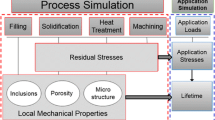Abstract
Metal castings are often questioned for their service life and reliability due to a lot of uncertainties associated with the process. It is important to virtually analyze these aspects of a cast product before it actually put into service. This paper presents a new approach to predict the fatigue life and reliability of ductile iron castings through coupled simulations and experiments. In this work, fatigue specimens are considered as sample cast products which are produced using an optimized mold design for minimum porosity. Radiographic examination is done to observe the quality of cast specimens. Experimental load-controlled fatigue testing of selected specimens is done and compared with simulated fatigue lives in fe-safe (Dassault Systems UK Limited 2015). Reliability of cast specimens under fatigue is computed using stress-strength model by considering the variability in both stress and strength. A safe load-induced stress is estimated to obtain infinite life of ductile iron parts under consideration. Furthermore, the reliability models are developed by fitting probability distributions to reliability estimates and determining the distribution parameters. It is concluded that the mold design optimization using casting simulations can lead to nearly defect free castings which can serve for the similar fatigue lives as their sound counterparts. Moreover, the probability of survival of the cast components for an infinite life can be computed using the classical stress-strength reliability model based on which safe loading conditions can be determined for almost any engineering application.





























Similar content being viewed by others
References
Bhatt H, Barot R, Bhatt K et al (2014) Design optimization of feeding system and solidification simulation for cast iron. Procedia Technol 14:357–364. https://doi.org/10.1016/j.protcy.2014.08.046
Sun Y, Luo J, Mi GF, Lin X (2011) Numerical simulation and defect elimination in the casting of truck rear axle using a nodular cast iron. Mater Des 32:1623–1629. https://doi.org/10.1016/j.matdes.2010.11.009
Hahn I, Sturm JC (2010) Autonomous optimization of casting processes and designs. In: World Foundry Congress, Hangzhou, China October. pp 16–20
Futáš P, Pribulová A, Fedorko G et al (2019) Failure analysis of a railway brake disc with the use of casting process simulation. Eng Fail Anal 95:226–238. https://doi.org/10.1016/j.engfailanal.2018.09.005
Ceschini L, Morri A, Morri A et al (2015) Microstructure and mechanical properties of heavy section ductile iron castings: experimental and numerical evaluation of effects of cooling rates. Int J Cast Met Res 28:365–374. https://doi.org/10.1179/1743133615Y.0000000022
Mourad MM, El-Hadad S, Ibrahim MM, Nofal AA (2015) Effect of processing parameters on the mechanical properties of heavy section ductile iron. In: J. Metall. https://www.hindawi.com/journals/jm/2015/931535/. Accessed 14 Jan 2018
Borsato T, Ferro P, Berto F, Carollo C (2017) Mechanical and fatigue properties of pearlitic ductile iron castings characterized by long solidification times. Eng Fail Anal 79:902–912. https://doi.org/10.1016/j.engfailanal.2017.06.007
Foglio E, Gelfi M, Pola A, Goffelli S, Lusuardi D (2017) Fatigue characterization and optimization of the production process of heavy section ductile iron castings. Int J Met 11:33–43. https://doi.org/10.1007/s40962-016-0112-9
Labrecque C, Gagné M, Cabanne P, François C, Becret C, Hoffmann F (2008) Comparative study of fatigue endurance limit for 4 and 6 mm thin wall ductile iron castings. Int J Met 2:7–17. https://doi.org/10.1007/BF03355424
Ferro P, Lazzarin P, Berto F (2012) Fatigue properties of ductile cast iron containing chunky graphite. Mater Sci Eng A 554:122–128. https://doi.org/10.1016/j.msea.2012.06.024
Jolly M (2003) Castings. In: Comprehensive structural integrity. Elsevier, pp 377–466
Niyama E, Uchida T, Morikawa M, Saito S (1982) A method of shrinkage prediction and its application to steel casting practice. AFS Int Cast Met J:52–63
Carlson KD, Beckermann C (2008) Use of the Niyama criterion to predict shrinkage-related leaks in high-nickel steel and nickel-based alloy castings. In: Proceedings of the 62nd SFSA Technical and Operating Conference. Steel Founders’ Society of America
Hattel J (2005) Fundamentals of numerical modelling of casting processes. Polyteknisk Forlag
Rao PN (2013) Manufacturing technology. Tata McGraw-Hill Education
(2015) ASTM E466 - 15 Standard Practice for Conducting Force Controlled Constant Amplitude Axial Fatigue Tests of Metallic Materials
Khan MAA, Sheikh AK (2018) Mechanical characterization and quality of iron castings using optimized mold design: simulations and experimental validation. Int J Adv Manuf Technol 98:1–11. https://doi.org/10.1007/s00170-018-2325-y
Dassault Systems UK Limited (2015) fe-safe User manual
Shigley JE, Mischke CR (1996) Standard handbook of machine design. McGraw-Hill
Woo S (2017) Reliability Design of mechanical systems: a guide for mechanical and civil engineers. Springer. https://doi.org/10.1007/978-3-319-50829-0
NDT Resource Center Materials and Processes - Fatigue Properties. https://www.ndeed.org/EducationResources/CommunityCollege/Materials/cc_mat_index.htm
Samar Ali S, Kannan S (2011) A diagnostic approach to Weibull-Weibull stress-strength model and its generalization. Int J Qual Reliab Manag 28:451–463. https://doi.org/10.1108/02656711111121834
Mardia KV, Zemroch PJ (1978) Tables of the F- and related distributions with algorithms. Academic Press; First Edition edition
Pearson ES, Pearson K, Hartley HO (1966) Biometrika tables for statisticians. Published for the Biometrika Trustees at the University Press
Acknowledgments
The authors would like to acknowledge the support provided by King Fahd University of Petroleum and Minerals and MAGMA in this research. Special thanks to Dr. Pasha from Mechanical Engineering Department at KFUPM in guiding the use of ABAQUS in pursuit of this work. Also thanks to Dr. Bilal Shaer from MASABIK foundry in facilitating the mold and pattern making and the casting runs at MASABIK to validate the proposed models.
Funding
This work is supported by The National Science, Technology and Innovation Plan (NSTIP), Saudi Arabia, under grant number 14-ADV890-04-R.
Author information
Authors and Affiliations
Corresponding author
Additional information
Publisher’s note
Springer Nature remains neutral with regard to jurisdictional claims in published maps and institutional affiliations.
Rights and permissions
About this article
Cite this article
Sheikh, A.K., Khan, M.A.A. Fatigue life prediction and reliability assessment of ductile iron castings using optimized mold design. Int J Adv Manuf Technol 106, 1945–1966 (2020). https://doi.org/10.1007/s00170-019-04504-5
Received:
Accepted:
Published:
Issue Date:
DOI: https://doi.org/10.1007/s00170-019-04504-5




